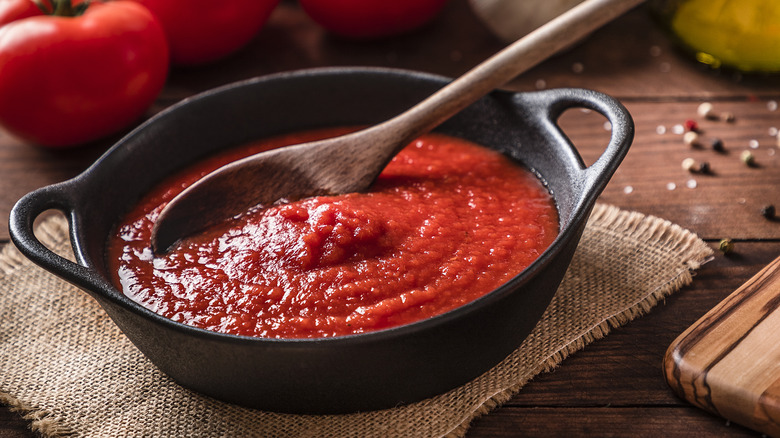Dehydrated Sauce Paper Is A Genius Way To Amp Up The Flavor Of Any Dish
Whether you're looking for a tasty snack or are interested in preserving food, dehydration is a simple process that can take your dishes to the next level. With nothing more than the press of a button, modern dehydrators can turn leftover pulp into tasty fruit leather while gently humming along on your counter. While you can (and should!) make classics like dried apple rings and beef jerky, don't limit yourself to the basics; the pantry and refrigerator are loaded with interesting dehydration potential.
To make a truly versatile ingredient, you can dehydrate your favorite sauce. When placed on a tray, dehydrated dips and liquids will form a well-preserved "sauce paper" that is a perfect complement for entrees and snacks alike. Sauce paper is long-lasting, simple to store, and offers cooks an easy way to quickly boost the flavor and depth of a dish. Prepare a few trays of sauce paper to stock your kitchen up with an arsenal of flavor.
Making and using sauce paper
To make a good sauce paper, start by choosing an appropriate sauce. Look for condiments and liquids that have a smooth, uniform texture. Even dehydration is dependent on a smooth sauce, so if you're going to use something chunky, throw it in the blender beforehand. Avoid options that contain lots of fat, like mayonnaise. Fat won't dehydrate well and can cause dried foods to go rancid quickly.
To make sauce paper, start by lining the trays with parchment paper or adding solid inserts designed to hold liquids. Pour your sauce evenly into the trays and set the temperature between 125 and 135 degrees Fahrenheit. Cooking times vary by model, but you should expect the sauce paper to take between six and 10 hours.
When your delicious sauces have hardened into a rigid paper, they're ready for use. Sauce papers can be cut into small pieces and added to individual dishes for extra flair and flavor. Try adding strips of sauce paper to soups, breads, and sandwiches. The heat from the dishes will slightly rehydrate the paper, turning it into a gooey flavor bomb.
Sauce paper is also an excellent option for spicing up your favorite camping meals. Pack your sauces on your next backcountry trip and enjoy the taste of fresh food. A bit of boiling water will quickly turn a sheet of tomato sauce paper into a steaming bowl of marinara.
Other ingredients to dehydrate
Beyond sauces, there are plenty of unusual items that also lend themselves to dehydration. You can dehydrate eggs to get a versatile egg powder. First, whip the eggs in a bowl until they are well mixed. Then, pour the liquid into the same dehydrator trays you'd use for sauce paper. When finished, your dehydrated eggs will have a dry, powdery texture. Dried eggs have a much longer shelf life than regular eggs and can be substituted in many of the same baking recipes.
You can also dehydrate canned tuna for a light snack. Make sure to use tuna that is packed in water. Like sauces, fish packed in oil will not dehydrate correctly and can quickly go rancid. Add your tuna to the dehydrator and let it cook until each piece is fully dried. To ensure even cooking, cut the tuna pieces to a uniform size before adding them to the dehydrator. When they are done, throw your tuna bits into small bags and enjoy a nutritional, lightweight snack on the go.


